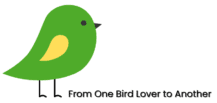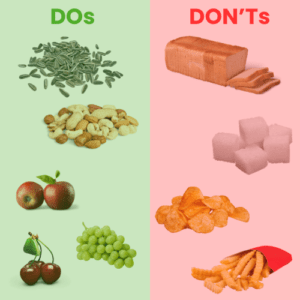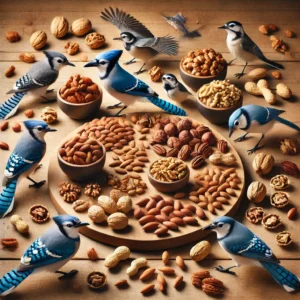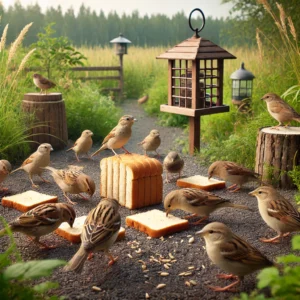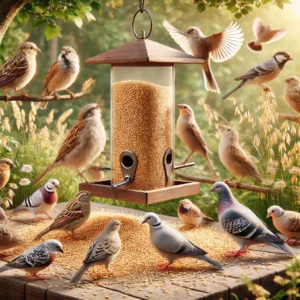Cracked corn for birds is one of the most popular and affordable food options for backyard enthusiasts. But it is the best option for your feathered friends? Let’s explore whether birds eat cracked corn, how to feed it, and what species enjoy it most.
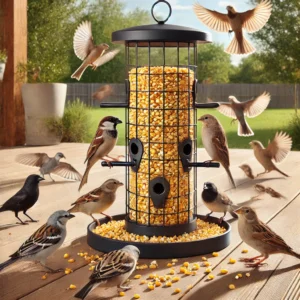
Advantages
Great Energy Source:
Cracked corn is rich in carbohydrates, making it an excellent, fast energy source for birds. This is particularly valuable during the winter months when food is scarce when birds need these carbohydrates to generate the heat they need to survive.
Perfect for Ground-Feeding Birds:
Birds like sparrows, doves, quail, juncos, and even turkeys enjoy it. Birds with stronger beaks can break down the larger pieces, which is why it is such a popular food choice in many backyards.
Affordable and Easily Available:
Cracked corn is often cheaper than other birdseed varieties, making it a cost-effective way to feed backyard birds. You can also mix it with other seeds to give your birds a more balanced diet.
Attracts Larger Birds:
If you want to attract larger species like crows, ravens, and grackles, cracked corn is a good option. Larger birds are drawn to corn for birds because of its high-energy content and larger size, which makes it an appealing food source.
Disadvantages
Attracts Other Wildlife:
While birds eat cracked corn, so do other animals like squirrels, raccoons, and even deer. If you’re spreading it on the ground, be prepared to encounter these visitors. To minimize this, consider using special feeders made for corn that are designed for birds but can limit access to other animals.
Spoils Quickly in Wet Weather:
If cracked corn gets wet, it can spoil quickly. Moldy corn is harmful to birds and should be avoided at all costs. To combat this, place the food in a weatherproof feeder or make sure the feeding area is well-drained and dry. Regularly clean up any uneaten corn to prevent mold from developing.
Low Nutritional Value:
While cracked corn is rich in carbohydrates, it doesn’t provide much else in terms of nutrition. It lacks fats, proteins, and vitamins, which are essential for a bird’s balanced diet. For this reason, it should be used as a supplement rather than a primary food source.
How to Feed Cracked Corn to Birds
Use Ground or Platform Feeders:
Ground-feeding birds like sparrows and doves are particularly attracted to cracked corn. Scatter it on the ground or use a platform feeder. Make sure to clean the area regularly to avoid attracting unwanted pests.
Mixing with Other Seeds:
It can be mixed with other seeds like sunflower, millet, or safflower to provide a more balanced diet. This ensures your birds get the necessary nutrients while enjoying the energy from the cracked corn.
Winter Feeding:
Since it is a high-energy food, it’s especially beneficial during the winter months when birds need more calories to stay warm. Offering it along with high-fat foods like suet or nuts helps birds maintain their energy levels during cold weather.
Read the Complete Guide to Feeding Birds in Winter.
What Birds Eat Cracked Corn?
- Doves: Species like the Mourning Dove are particularly fond of cracked corn.
- Sparrows: Many types of sparrows will happily eat corn for birds.
- Juncos: These small birds thrive on cracked corn, especially in the winter.
- Pheasants and Quail: These larger game birds also benefit from the energy provided by cracked corn.
- Blackbirds and Starlings: Larger birds such as blackbirds and starlings often flock to cracked corn when it’s available.
Do Birds Eat Corn Kernels?
Yes, many bird species, especially larger birds like crows and ravens, can eat whole corn kernels, but smaller birds prefer cracked corn since it’s easier to consume.
Conclusion: Is Cracked Corn Good for Birds?
In summary, cracked corn is a great food option for many birds, especially ground-feeding species. It’s affordable, energy-rich, and attracts a variety of birds to your yard. However, it should be supplemented with other seeds, fruits, and high-nutrient foods to ensure the birds get a balanced diet. Make sure to keep it dry and clean, and you’ll enjoy seeing a range of birds feasting in your backyard.
